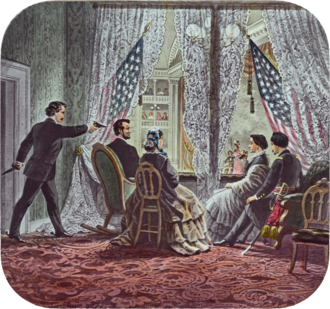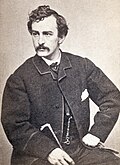Assassination of Abraham Lincoln

The assassination of Abraham Lincoln was one of the last events in the American Civil War, and happened on Good Friday, April 14, 1865. President Lincoln was shot while watching the play Our American Cousin at Ford's Theatre in Washington, D.C.. He died early the next morning.
Lincoln's killer, John Wilkes Booth, was an actor and Confederate supporter who had plotted with other men to kill the Secretary of State, William H. Seward and the Vice President Andrew Johnson. Booth hoped to create disorder and overthrow the Northern government by doing this. Booth was able to kill Lincoln, but Seward and Johnson survived. Lincoln was the first American president to be assassinated.[1]
Events
On April 14, Lincoln went to attend a play with his wife at Ford's Theatre in Washington, D.C..
During the third act of the play, following a line in the play that was the biggest laugh of the night, Lincoln was laughing at this line when he was shot.[2][3][4] John Wilkes Booth, a well-known actor and a Confederate spy from Maryland, entered the presidential box and fired a pistol at point-blank range into the back of Lincoln's head,[5] mortally wounding him. Lincoln immediately lost consciousness, but he passed into unconsciousness with laughter and a smile on his face.[6] Katherine M. Evans, a young actress in the play, who was offstage when Lincoln was shot but rushed onstage after Booth's exit stated "I looked and saw President Lincoln unconscious, his head dropping on his breast, his eyes closed, but with a smile still on his face".[6] Lincoln was carried across the street to Petersen House. He was placed diagonally on the bed because his tall frame would not fit normally on the smaller bed.[7] He remained in a coma for nine hours. He died the next morning.[8] As he died his breathing grew quieter, his face more calm.[9] According to some accounts, at his last drawn breath, on the morning after the assassination, he smiled broadly and then expired.[10][11][12][13][14] Historians, most notably author Lee Davis have emphasized Lincoln's peaceful appearance when and after he died: "It was the first time in four years, probably, that a peaceful expression crossed his face."[15] Assistant Secretary of the Treasury in the Lincoln Administration, Maunsell Bradhurst Field wrote, "I had never seen upon the President's face an expression more genial and pleasing."[12][16] The President’s secretary, John Hay, saw "a look of unspeakable peace came upon his worn features".[17]
After being on the run for 12 days, Booth was tracked down and found on a farm in Virginia, some 70 miles (110 km) south of Washington. After refusing to surrender to Union troops, Booth was killed by Sergeant Boston Corbett on April 26.[18][19]
Assassination Of Abraham Lincoln Media
Carte de visite of the actor John Wilkes Booth, c. 1865
Advertisement for Our American Cousin (Washington Evening Star, April 14, 1865)
Re-enactment of Lincoln's assassination, as portrayed in D. W. Griffith's silent-film The Birth of a Nation (1915).
The murder weapon is Booth's Philadelphia Deringer.
References
- ↑ Swanson, James (2006). Manhunt: The 12-Day Chase for Lincoln's Killer. Harper Collins. ISBN 9780060518493.
- ↑ Goodrich, Thomas (2006). The Darkest Dawn: Lincoln, Booth, and the Great American Tragedy. Indiana University Press. p. 96. ISBN 9780253218896.
- ↑ "1865 April 29: The National Calamity—Further Details of the Assassination". 29 April 2015.
A moment before the attack was made, the President was leaning forward, resting his head on his hand, in his accustomed careless way, his eyes bent upon the stage, and enjoying a hearty laugh.
- ↑ "Beatrice resident saw Lincoln shot".
I noticed that Mr. Lincoln was laughing at something in the play. Just then I noticed the curtain in the rear of Mr. Lincoln's box pulled apart and I looked squarely at the man as he came in. At first I thought he was one of the theater attendants bringing in a glass of water and decanter, for something shone in each of his hands. Just then a shot rang out.
- ↑ Swanson, James. Manhunt: The 12-Day Chase for Lincoln's Killer. Harper Collins, 2006. pp. 42–3. ISBN 978-0-06-051849-3
- ↑ 6.0 6.1 Timothy S. Good, ed. (1995). We Saw Lincoln Shot: One Hundred Eyewitness Accounts. University Press of Mississippi. pp. 148–149. ISBN 9780878057795. JSTOR j.ctt2tvdzz.
- ↑ Steers, Edward. Blood on the Moon: The Assassination of Abraham Lincoln. University Press of Kentucky, 2001. p. 123–24. ISBN 978-0-8131-9151-5
- ↑ "Abraham Lincoln". History. AETN UK. Retrieved 16 February 2014.
- ↑ Tarbell, Ida Minerva (1920). The Life of Abraham Lincoln. Vol. 4. p. 40. ISBN 9781582181257.
- ↑ Fox, Richard (2015). Lincoln's Body: A Cultural History. W. W. Norton & Company. ISBN 978-0393247244.
- ↑ Smith, Adam (8 July 2015). "With a smile on his face" – via content.The Times Literary Supplement.co.uk.
- ↑ 12.0 12.1 "Now He Belongs to the Ages - BackStory with the American History Guys".
Abraham Lincoln died, according to press reports, with a smile on his face. "I had never seen upon the president's face an expression more genial and pleasings," wrote a New York Times reporter.
- ↑ Abel, E. Lawrence (2015). A Finger in Lincoln's Brain: What Modern Science Reveals about Lincoln, His Assassination, and Its Aftermath. ABC-CLIO. Chapter 14.
- ↑ "President Lincoln's Thoughts on April 14, 1865".
When he finally gave up the struggle for life at 7:22 A.M., his face was fixed in a smile, according to one bedside witness, treasury official, a smile that seemed almost an effort of life. Lincoln has passed on smoothly and contentedly, his facial expression suggesting that inner peace that prevailed as his final state of mind.
- ↑ Assassinations That Changed The World, History Channel
- ↑ OUR GREAT LOSS; The Assassination of President Lincoln.DETAILS OF THE FEARFUL CRIME.Closing Moments and Death of the President.Probable Recovery of Secretary Seward. Rumors of the Arrest of the Assassins.The Funeral of President Lincoln to Take Place Next Wednesday.Expressions of Deep Sorrow Through-out the Land. OFFICIAL DISPATCHES. THE ASSASSINATION. Further Details of the Murder Narrow Recape of Secretary Stanton Measures Taken is Prevent the Escape of the Assassin of the President. LAST MOMENTS OF THE PRESIDENT. Interesting Letter from Maunsell B. Field Esq. THE GREAT CALAMITY.. 1865-04-17. . https://www.nytimes.com/1865/04/17/news/our-great-loss-assassination-president-lincolndetails-fearful-crimeclosing.html. Retrieved 2016-04-12.
- ↑ Hay, John (1915). The Life and Letters of John Hay Volume 1 (quote's original source is Hay's diary which is quoted in "Abraham Lincoln: A History", Volume 10, Page 292 by John G. Nicolay and John Hay). Houghton Mifflin Company.
- ↑ Steers, p. 153.
- ↑ Donald (1996), p. 599.
Other websites
| Wikimedia Commons has media related to Lua error in Module:Commons_link at line 62: attempt to index field 'wikibase' (a nil value).. |







